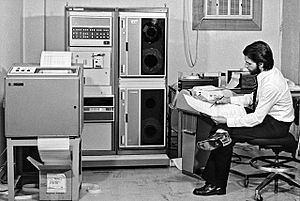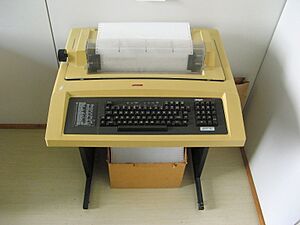The Oregon Trail (1971 video game) facts for kids
Quick facts for kids The Oregon Trail |
|
|---|---|

Picture of teleprinter output of the game, featuring a single round of gameplay
|
|
| Developer(s) | Don Rawitsch, Bill Heinemann, and Paul Dillenberger |
| Publisher(s) | MECC |
| Series | The Oregon Trail |
| Platform(s) | Minicomputer (HP 2100) Mainframe (CDC Cyber 70/73-26) Apple II, Atari 8-bit, Commodore 64 |
| Release date(s) | Original
|
| Genre(s) | Strategy |
| Mode(s) | Single-player |
The Oregon Trail is a classic computer game first made in 1971. It was created by Don Rawitsch, Bill Heinemann, and Paul Dillenberger. Later, the Minnesota Educational Computing Consortium (MECC) helped share it with many schools. The game was designed to teach students about what life was like for pioneers in the 1800s. These pioneers traveled along the real Oregon Trail.
In the game, you lead a group of settlers in a covered wagon. Your journey starts in Independence, Missouri, and ends in Oregon City, Oregon. You have to buy supplies, find food, and make important choices. You'll also face unexpected events like storms or your wagon breaking down. The very first versions of the game didn't have pictures. They used teleprinters, which printed text on paper, instead of computer screens. Later versions, especially for the Apple II computer, added simple graphics.
The first game was a big hit with students. It was later improved by MECC in 1975. They made it more historically accurate. As personal computers became popular, MECC released the game for many different systems. This included the Apple II, Atari 8-bit computers, and Commodore 64. In 1985, a new, fully graphical version was released. The Oregon Trail is the first game in a popular series. The games have sold over 65 million copies. They are even in the World Video Game Hall of Fame.
Contents
How to Play The Oregon Trail
The Oregon Trail is a text-based strategy video game. This means you read text and make choices. You play as the leader of a wagon train. Your goal is to guide your group from Independence, Missouri, to Oregon City, Oregon, in the year 1847.
Starting Your Journey
First, you buy supplies for your trip. These include food, bullets, clothes, and other items. You also need cash. The journey is broken into about twelve parts. Each part represents two weeks on the trail.
Making Choices on the Trail
At the start of each part, the game tells you how far you've traveled and the date. It also shows your current supplies. You can choose to hunt for food. Sometimes, you can stop at a fort to buy more supplies. You also decide how much food your group will eat.
Facing Challenges
After your choices, the game creates random events. These can be storms that damage your supplies. Your wagon might break down. You could also be attacked by wild animals or "hostile riders." The weather can also change, slowing you down. This might mean you need more time to reach Oregon.
Hunting and Survival
When you hunt or are attacked, the game asks you to type a word quickly. In the first game, it was "BANG." Later versions used words like "BANG" or "POW." If you type it fast and correctly, you get more food when hunting. The game ends if you reach Oregon. It also ends if your group dies along the trail. This can happen if you run out of supplies or get sick. For example, running out of food leads to starvation. Lack of warm clothes in cold weather can cause illness. Snakebites or hunting accidents can also make you sick. If you don't have supplies or money for a doctor, your group might not survive.
How The Oregon Trail Was Made
The First Version
In 1971, Don Rawitsch was a student teacher. He was teaching an 8th-grade history class in Minneapolis. He needed to create a lesson about the "Western Expansion." Rawitsch decided to make a board game about the Oregon Trail. His roommates, Bill Heinemann and Paul Dillenberger, were also students. They knew about computer programming. They suggested making it a computer game instead. A computer could keep track of everything and calculate chances.
They worked very hard for two weeks. The Minneapolis school district had a special HP 2100 minicomputer. Schools could connect to it using a single teleprinter. These teleprinters could print messages from programs. The three students designed and coded the game on paper first. Rawitsch focused on the history and design. Heinemann and Dillenberger did the programming. They worked on the teleprinter in a small room at their school.
They created the main parts of the game. This included buying supplies, making choices, and the hunting game. They also added random events. Heinemann thought it would be cool to link events to the trail's geography. For example, cold weather would be more likely in mountains. Attacks would be more likely in plains. They also made sure outcomes were a little different each time. This kept the game interesting for players.
Students loved the game. They even stayed late at school to play! Other teachers suggested changes. They wanted to make sure the game showed Native Americans in a fair way. The original ideas were sometimes based on old Western movies.
The Oregon Trail was first played by Rawitsch's classes on December 3, 1971. Students lined up to play. Only one student could use the teleprinter at a time. So, students played in groups. They voted on choices and helped each other. Other teachers also found ways for their students to try the game. The team fixed small problems in the game as students played. Soon, schools across the city were playing it. When their teaching term ended, they printed out the game's code. Then, they removed the program from the computer.
The MECC Version
In 1974, Rawitsch started working for the Minnesota Educational Computing Consortium. MECC was a group that made educational software for schools. MECC had a large mainframe computer. Schools all over the state could connect to it. Rawitsch's boss said he could add programs to the system.
With permission from his friends, Rawitsch put the game's code into the MECC system. This was in 1974. He also made the game better. He researched real historical events on the Oregon Trail. He changed how often random events happened. For example, bad weather or wagon breakdowns were based on actual historical chances. He read old diaries and stories from pioneers to get these facts. He also added more positive parts about Native Americans. His research showed that many settlers got help from them. In 1975, The Oregon Trail was available to schools across Minnesota.
The Game's Impact
The 1975 mainframe game was very popular in Minnesota schools. Thousands of students played it every month for five years. The original creators, Rawitsch, Heinemann, and Dillenberger, were not publicly known until 1995. MECC honored them in a special ceremony.
In 1978, Rawitsch shared the game's code in a magazine called Creative Computing. That same year, MECC started encouraging schools to use Apple II microcomputers. They bought many Apple IIs at a discount and sold them to schools. MECC began changing their games to work on these new computers.
John Cook adapted The Oregon Trail for the Apple II. The game was still mostly text-based. But he added a map that showed the player's location. He also changed the hunting and attack parts. Instead of typing, a deer or attacker would move on the screen. Players pressed a key to shoot. A version for Atari 8-bit computers came out in 1982. The Apple II version was also part of a collection called Elementary Volume 6 in 1980. This was given free to Minnesota schools and sold elsewhere. A version for the Commodore 64 was released in 1984. By the mid-1980s, The Oregon Trail was MECC's most popular product.
In 1985, MECC released a new, fully graphical version for Apple II computers. R. Philip Bouchard redesigned it. This new The Oregon Trail was a huge success. Along with other games in the series, it sold over 65 million copies. Many more games have been released in The Oregon Trail series. Some spin-off games like The Yukon Trail and The Amazon Trail were also created.
The Oregon Trail is seen as a very important game. It's often called one of the first "serious games" because it teaches you things. Both the text-based and graphical versions are often thought of as the same game. Many people call it a "cultural icon." It's also known for being a great example of "edutainment." Because it was so popular, The Oregon Trail was added to the World Video Game Hall of Fame in 2016. Time magazine named it one of the 100 greatest video games in 2012. In 2016, they put it at number 9 on their list of the 50 best games.
See also
 In Spanish: Oregon Trail (videojuego) para niños
In Spanish: Oregon Trail (videojuego) para niños



